#lateral hiring in India
Explore tagged Tumblr posts
Text

Discover how TruFynd, India’s leading recruitment agency and HR consultancy, is transforming the way businesses attract, train, and retain top talent. Offering specialized solutions, expert guidance, and innovative practices, TruFynd ensures organizations achieve workforce excellence. Explore our approach to creating impactful partnerships between employers and employees.
#TruFynd recruitment services#HR consultancy in India#employee training programs#workforce management#lateral hiring in India#executive recruitment#niche role hiring#top recruitment agency#HR solutions provider#TruFynd Ahmedabad
0 notes
Text
EXCLUSIVE: One year ago we told you that a second season of John le Carré adaptation The Night Manager was quietly being developed under the codename Steelworks.
Now, Deadline can reveal that the BBC and new co-pro partner Amazon have gone big on a supercharged two-season order of the thriller, with Tom Hiddleston returning to lead, Hugh Laurie coming back as EP and with a new director in I Hate Suzie’s Georgi Banks-Davies. A third season has also been greenlit. David Farr returns as writer and Stephen Garrett is showrunner.
The Night Manager Season 2 will begin filming later this year and will pick up with Hiddleston’s Jonathan Pine eight years after the explosive finale of Season 1, going beyond the original book, which was written by the celebrated British writer in 1993. Additional plot details are being kept under wraps and there is not yet confirmation as to whether EP Laurie’s Richard Roper, who was last seen in the back of a paddy wagon driven by arms buyers who were not best pleased with him, will return to star. Hiddleston will also EP and will discuss in more depth on tonight’s Jimmy Kimmel Live!
Produced by The Ink Factory in association with Character 7, Demarest Films and 127 Wall, and in co-production with Spanish partner Nostromo Pictures, The Night Manager Season 2 was sold to Amazon by Fifth Season. The first was co-produced with AMC.
New director Banks-Davies, a BAFTA-nominee who takes over from Susanne Bier, has credits including I Hate Suzie, Garfield and upcoming Netflix series Kaos.
The Night Manager Season 1 was a huge success, watched by millions and winning multiple BAFTAs, Emmys and Golden Globes including best actor for Hiddleston. Also starring Tom Hollander, Olivia Colman and Elizabeth Debicki, it followed Pine – who ran a luxury hotel in Cairo – as he attempted to infiltrate the inner circle of Roper’s crime syndicate after being hired by Foreign Office task force manager Angela Burr.
The first season was commissioned more than 10 years ago and the show has since been remade in India, lapping the UK version by swiftly having a Season 2 greenlit for Disney+ Hotstar in May last year.
Simon Cornwell and Stephen Cornwell, le Carré’s sons who run The Ink Factory, said Season 1 proved “a landmark moment for the golden era of television – uniting on-screen and behind-the-camera talent at the top of their game – and an audience reception which was beyond our wildest imagining.”
They added: “Revisiting the story of Pine also means going beyond the events of John le Carré’s original work: that is a decision we have not taken lightly, but his compelling characters and the vision David has for their next chapter were irresistible.”
Amazon MGM Studios Head of Television Vernon Sanders said: “We are elated to bring additional seasons of The Night Manager to our Prime Video customers. The combination of terrific source material, the wonderful team at The Ink Factory, a great writer in David Farr, an award-winning director in Georgi Banks-Davies, as well as the talented cast truly make the series the full package.”
Hiddleston said: “The first series of The Night Manager was one of the most creatively fulfilling projects I have ever worked on. The depth, range and complexity of Jonathan Pine was, and remains, a thrilling prospect.”
BBC content boss Charlotte Moore added: “After years of fervent speculation I’m incredibly excited to confirm that The Night Manager is returning to the BBC for two more series.”
The Night Manager series two is created and executive produced by Farr, based on the characters created by le Carré. Additional executive producers include Garrett for Character 7, Banks-Davies, Laurie and Hiddleston; Joe Tsai and Arthur Wang for 127 Wall; Stephen and Simon Cornwell, Michele Wolkoff, and Tessa Inkelaar for The Ink Factory; Adrián Guerra for Nostromo Pictures; William D. Johnson for Demarest Films, Nick Cornwell, Susanne Bier, Chris Rice for Fifth Season and Gaynor Holmes for the BBC.
#tom hiddleston#the night manager#seasons 2 and 3#official#jonathan pine#hugh laurie#booked and busy
99 notes
·
View notes
Photo

Battle of Plassey
The Battle of Plassey on 23 June 1757 saw Robert Clive's East India Company army defeat a larger force of the Nawab of Bengal. Victory brought the Company new wealth and marked the beginning of its territorial expansion in the subcontinent. Not much more than a skirmish, Plassey has often been cited as the beginning of British rule in India.
Clive & the Expansion of the EIC
The East India Company (EIC) was founded in 1600, and by the mid-18th century, it was benefiting from its trade monopoly in India to make its shareholders immensely rich. The Company was effectively the colonial arm of the British government in India, but it protected its interests using its own private army and hired troops from the regular British army. By the 1750s, the Company was keen to expand its trade network and begin a more active territorial control in the subcontinent.
Robert Clive (1725-1774) had already distinguished himself in the Company service at Arcot in August 1751 where he had led his troops to withstand a 52-day siege. This was followed by a victory at Arni in December 1751. Clive then commanded the EIC artillery at Trichinopoly in June 1752. By 1755, Clive was a lieutenant colonel in the EIC army, and his name was under consideration to become the next Governor of Madras, but Bengal was the real trouble spot for the East India Company.
There was a new ruler of Bengal, Nawab Siraj ud-Daulah (b. 1733). Only assuming the role in April 1756, Siraj ud-Daulah, was in his early twenties and was something of a reckless youth. He was a surprising choice to inherit the nawab role from his grandfather Ali Vardi Khan. The decision to make Siraj ud-Daualah the crown prince four years earlier had already split the Bengal royal court just when unity was required to face its greatest challenge.
The new nawab took exception to the EIC presence in the region and marched on Calcutta in June 1756. Siraj ud-Daualah was particularly angry that the EIC had added to the fortifications of Calcutta without permission and had not responded favourably to his request to remove them. Arriving in the city with his army, a short siege followed, and Calcutta fell. The EIC was already obliged to respond to the loss of one of its most important trading centres but a curious incident then occurred which stiffened the resolve of the militarists in the Company and weakened the position of those who wished for the EIC to remain a purely trading body. After the fall of Calcutta, a number of military personnel and civilians who had been in the city's fort were taken prisoner and held in a small, poorly lit, and badly ventilated prison cell locally known as the Black Hole of Calcutta. According to one prisoner, only 23 men of the original 146 male and female prisoners survived the confinement, all the others died of extreme dehydration in the terrible heat of the packed cell. The effect of the Black Hole story was to galvanise the military response from the EIC.
Robert Clive was dispatched with an army to re-establish the EIC's trading presence in Calcutta. Sailing in five ships and with an army of some 1,500 men, Clive succeeded in recapturing Calcutta in January 1757, but Siraj ud-Daulah still had a massive army at large. What is more, the rival French East India Company was in control of Chandernagore just up the coast. Clive was determined on a decisive military action. He captured the fort of Hughli later in January, which was then destroyed by cannon fire from the EIC fleet. An attack on the nawab's army outside Calcutta was less successful and obliged Clive to retreat. Both sides became wary of the other and the heavy casualties any future confrontation would bring, but the control of Bengal was now at stake. A peace treaty was agreed upon, although both sides knew this was but a temporary pause. In the interim, Clive could now deal with the threatening French presence in the region. In March 1757, Clive attacked and captured Chandernagore, bringing an end to any remaining ambitions the French had in Bengal. When the Hindu Seths of Murshidabad, a dynasty of financiers worried at the demise in European trade any wider conflict would bring, withdrew their support of the now isolated nawab, Clive seized the moment.
Continue reading...
23 notes
·
View notes
Text
Just been thinking (again) about Charley being called an ‘Edwardian Adventuress’ and how much it annoys me (yes, I know they fudged an explanation in a later audio that I haven’t heard; it still bugs me).
I’m glad India didn’t go and hire a ‘nice Edwardian outfit’ for the live show as putting Charley in that sort of costume would have looked ridiculous given the massive change in fashion after the death of Edward VII in 1910 (the end of the Edwardian era) and the First World War that followed four years later. Though I’m sure a lot of older women like Lady Louisa would have taken a while to adapt to the new styles and doubtless disapproved of rising hemlines and flapper dresses, Charley was born in 1912 so has grown up during that era of change and I have no doubt that she would embrace such fashions with gusto. I mean, just look:
Here we have some Edwardian dresses, the kind of thing that would have been worn by Charley’s mother before Charley was born and were two decades out of date by the time she stowed away on the R101:





1910s, as thing start to change more:





1920s fashions, when Charley would have entered her teens:





And finally the early 1930s, around the time she left in the TARDIS:





As you can see, there’s a huge difference! India could have quite easily found an appropriate costume that didn’t rustle if not for that erroneous ‘Edwardian’ tag.
#it really does irritate me and has done since the beginning#the world experienced a massive upheaval with the great war and so much changed in those two decades#charley definitely isn’t a product of the edwardian era#doctor who#charley pollard#big finish#period costume#twentieth century#this has been a period costume nerding post
19 notes
·
View notes
Text
According to the screenshots provided by [German researcher & historian Henrik Schönemann], the list includes (all of the following are direct quotes):
$78,000 to Palestinian activist group whose chairman was photographed attending an anniversary event celebrating the founding of the Popular Front for the Liberation of the Palestine terrorist group
$1 Million for foreign DEI programs, including ‘indigenous language technology’ in Guatemala, per non-public funding docs reviewed by WFB
$5 million for effort to treat eating disorders by “affirming” LGBTQIA+ patients’ sexual orientation and gender claims
Up to $3 million to defund the police advocacy group to pursue “climate justice” for convicts
Funded performances of play “Angels in America: A Gay Fantasia on National Themes,” in which God is bisexual and communists are good, in North Macedonia
Disbursed $15,000 to “queer” Muslim writers in India
Shelled out tens of thousands to create army of 2,500 LGBTQI+ allies
Up to $10 million worth of USAID-funded meals went to al Qaeda-linked terrorist group the Nusra Front
$500,000 to group that “empowers women” in attempt to solve sectarian violence in Israel just ten days before Hamas’ Oct. 7 attacks
$4.67 million to EcoHealth Alliance – one of the key NGOs funding bat virus research at Wuhan Institute of Virology — in late 2021. Later refused to answer key questions about the funding.
$7.9 million to a project that would teach Sri Lankan journalists to avoid “binary-gendered language”
$1.3 million to Arab and Jewish photographers
$1.5 million for “art for inclusion of people with disabilities”
$2 million to promote “LGBT equality through entrepreneurship…in developing Latin American countries.”
Education Week: “Biden Administration Cites 1619 Project as Inspiration in History Grant Proposal”
VA took at least a dozen actions aimed at bolstering DEI during the Biden-Harris administration while the number of homeless veterans increased and the amount of claims in the VA’s backlog grew from ~211,000 to ~378,000
NASA has allocated roughly $10 million to grants advancing DEI and “environmental justice” since 2020
Following President Trump’s executive order on DEI at federal agencies, the ATF “quietly changing the job title of its former diversity officer… to ‘senior executive’ with the ATF.
The Department of Labor requested additional funding in 2023 for “The Chief Evaluation Office for a new rigorous interagency evaluation of actions aimed at improving Diversity, Equity, Inclusivity, and Accessibility across the federal workforce,” more than $6.5 million “to restore employee benefits programs that will advance equity by specifically addressing how opportunities can be expanded for underserved communities and vulnerable populations,” and $5 million “to evaluate actions aimed at improving diversity, equity, inclusion, and accessibility (DEIA) within the federal workforce.”
Fox Business: “FOX Business’ ‘Trouble in the Skies,’ a six month investigation of the FAA’s new hiring practices, uncovered changes that may put the nation’s flying public at risk as well as allegations that the newest air traffic control recruits had access to answers on a key test that helped them gain jobs with the FAA…Also uncovered was an FAA effort to promote diversity that discarded 3000 qualified college graduates with degrees in air traffic control despite their following FAA procedure and obtaining FAA accredited degrees.”
Schönemann told 404 Media he wanted to share a sentiment alongside his find: “People all around the world care, you are not alone. And: #TransRights.”
Earlier this week, we reported that the Trump administration had set up a website called waste.gov, which was live on the internet with a sample page from a default WordPress template. Both DEI.gov and waste.gov were created at the same time, according to Reuters, and DEI.gov was recently set up to redirect to waste.gov. After our reporting, both websites were put behind a password wall.
#I just decided to paste the substance of the article here since clicking through is difficult + it wants you to sign up for an email list#but its um.... well you see why i think it is worth reading
11 notes
·
View notes
Text
SOOOOO, potentially a new hc backstory to Hook based on chats with a friend and more research cause HISTORY~
Posting under the cut first just to make sure it makes sense and to get peoples thoughts (those who know the OG story I went for)
83
Raised in a noble, rich household, James Francis Bartholomew Jackson was set to inherit his father’s business as a London Merchant, who owned three merchant vessels and a grand wealth and home. In reality, James senior, his father, was not really his father. James was bore from his mother’s love to a lowly footman in their home and despite keeping it secret, the truth was known after James’s mother passed away at age 4 and to keep the scandal secret, his father sent James’s real father to his death.
No one else knew. Any confession his wife had written was thrown in the fire, his anger towards his wife and her lover extended to young James and yet without this boy, his wealth would dwindle to nothing and his legacy for nought and by now he could not rid himself of the bastard child. Especially he had built himself up to be the boy’s father.
James would never remember his mother well and he would never know the truth about his real father until much later in his life. He never saw his real father.
In 1664 a young 12 year old James went to sea, working as an apprentice to the quartermaster on board an East India Trading Company vessel. He sailed with the promise and a contract to the ship, to return home in no more than a years time to take on more of his duties as a heir to his father’s fortune and business (as well as to confirm his betrothal to a gentry girl.)
However, he never returned to England.
After sailing on the merchant ship for a year, James was called to enlist into the navy as part of the second anglo-dutch war, he took part in a battle against Dutch ships and saw many deaths and sinking from the mere age of 14 as an apprentice officer.
As the Plague of London erupted, followed by the Great Fire of London, he was taken out of the navy along with many others as a means for the government to save money and soon rejoined another merchant ship.
Hook sailed on a total of 5 different merchant ships for a grand total of 13 years after leaving the navy. The truth of his birthright came about through a letter. The letter stated that Hook was not set to inherit his father’s title, business or money, he was bankrupt and cast aside after the death of his father who confessed before death that James was not his son and he kept it secret to avoid the scandal.
The blow of the news was only overshadowed by the Officers and Captain on the ship he served who took it as a ‘kindness’ to not throw him overboard and stripped him of all rank, titles and honours. Treating him with evil distain for the rest of his voyage.
Until the year 1703, where at the age of 27, James took part in the mutiny of the ship and became a pirate Captain.
For 10 years, James was known as both ‘Mutiny Red’ and ‘Scarlet Jim’ (Jas to his friends) and sailed across the world plundering, stealing and ransacking other ships, getting away with it at times for being hired as Privateers, escaping or disguising themselves.
Then, one day, himself and his crew were struck by an horrendous and strange storm. When Hook awoke, he was amongst the wreckage of his ship in a new world, where the sky, the sea and the people were so different and magical…. The Never Realm.
Rescued and taken in by a man named Mr Smee, James and the members of his surviving crew rebuilt the ship and discovered the island ‘Neverland’ where he came across an orphan boy who didn’t seem to age…
The rest is history.
12 notes
·
View notes
Text
IWTV Musings - Tentative Timeline (Pt5a: 1300s - 1600s) - TVC Only (TVA, B&G)
This timeline covers mostly The Vampire Armand and Blood & Gold. I've been wanting a detailed Marimand breakdown since forever, but no TVC timeline adequately covered everything. Welp, YOLO! 😤
Pt4a (text) & Pt4b (graph) covered TVC's dates from 1700s-1800s
Pt5a (text) & Pt5b (graph) covers TVC’s dates from 1300s - 1600s.
Pt6a (text) & Pt6b (graph) will cover AMC’s S1 & S2 version of dates from 1300s - 1920s.
1300s
1300s: Vampires
Pandora Turns Arjun in to a vampire in India. (AR is very vague about this happening during the Chola dynasty, like wtf, which one? 😅)
pre-1349: Fall of the de Landen coven
Most of Rhoshamanades' de Landen coven (Allessandra, Eleni, Eugene, Everard) is kidnapped by the Children of Satan and taken to Rome. (Again, AR's hella vague about when this all happened, just that it's during the 14th century. But Allesandra's already in the Roman coven when Santino's Turned, so at least that narrows it down to pre-1346-1348).
1346 - 1353: The Black Plague kills ~60% of Europe's population
1347 - 1348: The Black Plague in Italy. Marius witnesses the Plague in Venice (1347-48) & Florence (1348). Goes to ground for ~130+ years.
c. 1348-1349: Santino is Turned into a vampire during the Plague. (The wiki says he was Turned c. 1350, but TVL says 1349, so IDFK.

1400s
1473 - 1481: Pope Sixtus IV builds the Sistine Chapel (Michelangelo paints the ceiling in 1508)
1481: Andrei born in Kiev Rus (AR called it the Golden Horde, but more accurately it would be during the time of the Great Horde). (Riccardo would've had to have been born before this, as the oldest boy in Marius' palazzo.)
1482: Botticelli
Marius wakes from his torpor. Visits Rome & the Sistine Chapel. That same night, Santino & Marius meet. The Children of Satan in Rome are only "a dreadful few." Santino rejected & salty. The next night, Marius goes to Florence searching for Botticelli.

For months, Marius simps for Botticelli. 2 rogue vampires live in Florence, and beg Marius not to Turn Botticelli into a vampire. He agrees.

Weeks later, Marius paints for TWMBK in their Alps hideout. Marius travels to North Europe but hates the Northern Renaissance (van Eyck d. 1441; van der Weyden d. 1464, van der Goes d. 1482, Hieronymus Bosch d. 1516, etc). Finally returns to Italy for good.

1485: Andrei taught to be a hunter by his father "Ivan the Idiot," a great hunter, ("The boy has hunted with Ivan since he was four years old").
1480s - 1490s: Venice
Marius settles down in Venice. Hires Vincenzo. Purchases the palazzo. Opens his art studio & adopts in his first apprentices. ("Riccardo was won in a card game from his drunken Father by a beastly merchant who worked him night and day. Riccardo detested his Father, which you never have. Riccardo was eight years old when I bought him for the price of a gold necklace.") British Talamascan teenager Raymond Gallant spies on Marius in Venice for years. ("'One of us saw you and wrote a letter to our Motherhouse in England, and I was dispatched to make certain of who and what you were. Once I glimpsed you in your own house I knew it to be true.")

Months - years pass (Marius' boys become adults and go to the University of Padua)

c. 1490: Carpaccio's Meditation on the Passion inspires Marius' art.
("I drifted out in the following weeks to all the churches once more in search of inspiration for my paintings, and I studied many a grotesque and bizarre picture which amazed me almost as much as my own work. An artist by the name of Carpaccio had created a work called Meditation on the Passion which revealed the body of the dead Christ environed against a fantastical landscape, and flanked by two white-haired saints who peered at the viewer as if Christ were not there!")
c. 1492: Befriends 19-20yo courtesan Bianca Solderini.
1 - 2 years later

Marius ghosts Bianca "for nights, no, months," scared he'll Turn her into a vampire. Deciding not to Turn Bianca, Marius goes to her salon "for months" before realizing she's an assassin, killing her johns.
pre-1496: Andrei paints for Princes Michael & Feodor.
Andrei's father Ivan is an abusive father who beats Andrei "senseless," not wanting him to join the Monastery of the Caves and be buried alive by the Elders as a fanatical monk. ("And your father hated them that they did not let you paint, that they made you a monk above all things.") Ivan wanted Andrei to paint ikons for Prince Michael & Prince Feodor.

I have no idea who TF Prince Michael & his cousin Feodor are--way too common names with the most CURSED effing spelling variations I've ever seen. (I was esp. confused cuz AR contradicted herself, calling Feodor Michael's brother and cousin, lord have mercy.) I know literally nothing about princes under the Kiev Voivodeship of Lithuania, but unless there's any Feodor cousins attached to Mykhailo Hlynsky (Michael Glinski d. 1534) or Mikhail III Borisovich of Tver (1453 – 1505), I doubt those are the right Michaels. And I doubt Feodor is any of these dudes x x x. But it CAN'T be Mikhailo Olelkovich (r. 1454–1481) and his cousin Feodor Ivanovich Belsky (Fedir Bilsky d. c. 1506), cuz Michael was executed in 1481--the year Andrei was BORN. So IDFK. 🤦
1496: Amadeo.
During the journey to deliver Andrei's ikons to Prince Feodor, their group is attacked. ("Amadeo's father, the hunter who had taken him out of the monastery that day for a dangerous mission, to ride out in search of a fort which the Mongols had already destroyed.")
Andrei (approx 15yo) kidnapped by Tartars & sold by Greek Turks into sex slavery. Shipped from Constantinople to a brothel in Venice. Marius overhears Andrei crying across the city, buys him from the brothel, renames him Amadeo. Marius already knows he'll groom Amadeo to be his "Child of the Blood/ Blood Child."

"By the end of the week, I couldn't even remember one word of my Mother Tongue."
SUMMER 1496: Amadeo's education
"For months to come," Amadeo is educated as a Venetian princeling. Marius seduces Amadeo with Blood Kisses, making him his "kept boy." Everyone knows Amadeo sleeps in Marius' bed.

Amadeo's education continues. He quickly becomes spoiled, lazing away the "hot afternoons," and wandering off on his own. He's never punished, but (big brother) Riccardo is, whenever Amadeo gets too reckless/careless with his own safety.

WINTER 1496: Bianca
"In the early and beautiful months of winter," the boys introduce Amadeo to Bianca. Marius asks Bianca to be his hostess. 1 month later, Marius opens the palazzo to the public for house parties. (Is this Christmas? Yule/Winter Solstice? Saturnalia?)

1497: Religiosity
c. January 1497: from boy to man
1 month afterwards, Amadeo has PTSD in the Byzantine Assunta church in Torcello, and gets a bad fever. Marius gives him healing Blood, but nothing can heal Amadeo's old trauma of being kidnapped & sold. ("Don't chase these memories.... Don't go to the church of Torcello to find them. Don't go to the mosaics of San Marco. In time all these harmful things will come back.")
February 7, 1497: Bonfire of the Vanities, led by religious reformer Girolamo Savonarola (d. 1498).
Botticelli is a follower of Savonarola, and his painting style/themes drastically changed in the 1490s; and he even burned up some of his own paintings. Marius is super disappointed. ("The teachers took the boys to Florence that they might see the paintings there. And all came home more truly inspired to study than before. Yes, they had seen the work of Botticelli, and how splendid it was. Was the Master painting? Indeed, so, but his work had become almost entirely religious. It was due to the preaching of Savonarola, a stringent monk who condemned the Florentines for their worldliness.... Botticelli believed in him, and was thought to be one of his followers. This saddened me greatly. Indeed it damn near maddened me. But then I knew that whatever Botticelli painted it would be magnificent.")
WINTER 1497 OR WINTER 1498: Sexcapades
1 year after arrival (1497) or his education (1498), he demands Marius have sex with him properly, but Marius' dead vamp peen doesn't work. 🍆🦴💀

⚠️ I DEEPLY suspect there's another 1yr timeskip. ⚠️
In TVA Armand talks as if he confronted Marius for sex 1yr after he arrived, and Marius sending him on sexcapades immediately afterwards. But IMO, way more time had passed. Cuz apparently everything leading up to Amadeo's vampirism happens almost immediately after Amadeo returns, which doesn't line up right at all, cuz we KNOW Amadeo was with Marius for 2yrs (although TVL says "Two years? Three years? No words to recreate it or embrace it, the glory that was those times"). We KNOW Amadeo was sent on his sexcapades after the Bonfire of the Vanities, but I don't think it was that same year, but the year afterwards. What makes it esp. confusing is cuz everything always happens in the frikkin winter; which would make sense why AR/Armand confused/compressed the timeline. So I'm gonna mark with a ⚠️⏰⚠️ everything that TVA seems to imply happened in Winter 1497, that I suspect actually happened in Winter 1498 instead. Walk with me.
1498: Secrets Exposed
(2 years after Marius rescued Amadeo) A lot goes down:
Bianca matures from a young girl to a grown woman. She continues as his hostess. Marimand visit her salon nightly. Vincenzo grows so old he has a limp.
May 23, 1498: Savonarola executed
WINTER 1498: Vampires
⚠️⏰⚠️ Marius sends Amadeo on 2 different sexcapades (a straight one first and then a gay one) at fancy brothels, to sow his oats with human prostitutes, cuz Marius' dead peen can't bone him. 🦴Armand's bisexual awakening. Amadeo first sent to a female brothel (3 days). ⚠️⏰⚠️"Towards morning on the second night," Amadeo insists that he's "a man now," and is ready for all of Marius' Blood secrets. ⚠️⏰⚠️"The next night he dispatched me" to a male brothel....

Armand never even mentions in TVA that he saw the vampire who visited Marius' palazzo. And in B&G, Marius (naturally) skips over his effed up reactions to Amadeo post-sexcapades. But considering the REALLY tight window of events leading up to Amadeo's human death, IMO Mael's visit to Marius' palazzo in B&G happened during the 3-night intermission before Armand was sent to the gay brothel in TVA.
Mael visits Marius' palazzo, warning him that Santino's asking everyone about Marius & TWMBK.

On Mael's 2nd night at the palazzo, Amadeo sees Mael in Marius' palazzo and knows they're the same. "So you would make a blood drinker of that one." Mael goes home, and Marius plans to leave for "a few nights" to visit TWMBK, but Amadeo confronts him before he can leave, "Master, that one, the one who came, the one who just left you--" Marius tells Amadeo to not ask about Mael; then says he's gonna visit TWMBK, "I knew that the fate of Amadeo was sealed."
TVA never mentions any of this with Mael, which is super strange, like it's NBD that Armand saw immortals just chilling in his home. OR more likely, AR wanted to flesh out Mael & Avicus' story and shoved this new scene in; more an inconsistency than a retcon. But wtvr. 🤷
⚠️⏰⚠️ "The next night he dispatched me" to a male brothel (4 nights).

IMO Marius visited TWMBK in B&G while Amadeo was at the gay brothel in TVA. Amadeo was there for 4 nights, and Marius was with TWMBK for 1 week tops. Which makes sense, cuz Amadeo said that when he'd returned from the gay brothel and looked for Marius, "he was gone."
Marius visits TWMBK in the Alps ("Was I asking permission of Akasha and Enkil to make this child a blood drinker? Was I asking permission to admit Amadeo to the secrets of this ancient and unchangeable shrine? If I did ask, there came no answer. Akasha gave me only her effortless serenity, and Enkil his majesty.") Marius returns to Venice 1 week later.
⚠️⏰⚠️ While Marius was "gone," the next night after Amadeo returns from his sexcapades, Amadeo tavern-hops, and meets Lord Harlech, a violent psychotic English Earl "who's been practicing with the blade since before you were born," touring Venice to cheat on his Scottish wife with little boys. ⚠️⏰⚠️ After 3 nights staying in Lord Harlech's bed, Amadeo hides out at Bianca's house and has sex with her ("she was hardly helpless"). He stays at her house the next day, then goes back home that night.

⚠️⏰⚠️ At home, Marius is painting the iconic "Temptation of Amadeo" painting. Marimand argue; Amadeo axes down Marius' door ("If I'm an angel, paint me with black wings!"). Marimand corporeal punishment with the switch/whip(?). ⚠️⏰⚠️ Marius admits that Riccardo had spied on Amadeo with Lord Harlech (& Bianca) "two days ago," and scolds him for behaving recklessly with a British lunatic. 💀

⚠️⏰⚠️ The Slaughter of Bianca's Pimps ⚠️⏰⚠️ Marius takes Amadeo hunting with him ("Find the heaviest cloak to protect you against the winter."), letting Amadeo see him kill humans. When Amadeo fails to be shaken, Marius takes Amadeo to confront Bianca about her murders. "Marius de Romanus, you cannot judge me. Not you with your magician's powers, not you with your boys!" 💀👀�� Bianca explains how her brothers pimped her out. Marimand hunt them down. Amadeo calls says he's a "Fool for God" and a "Fool for you, [Master]." It's so iconic (esp. cuz of how it parallels him later being the coven's Fool for Satan....).

That dawn, Amadeo returns home and naps. "Only a few hours were allowed to me by fate." Bianca has already delivered a letter warning him to stay at home, cuz Amadeo's English lover, Lord Harlech, is on a manhunt looking for him, to steal him from Marius. The very same day, Lord Harlech attacks the palazzo, slaughtering 2 boys & fatally wounding Amadeo with a poisoned blade. Riccardo stabs Lord Harlech to death. Amadeo falls quickly into a fever ("Oh, just open the windows, open them on the winter; I don't care, open them!"), and has dreams/visions of a city with towers of glass as he lays dying. ("The hours ticked.") That night, Marius returns home and Turns Amadeo into a vampire. Amadeo is 17 years old.

(As for Lord Harlech's corpse, Marius "broke him into fragments and scattered those fragments to the wind. If the old tales are true that his shade will pine for the restoration of his body, then his soul wanders the winds.")
The order of AR's timeline in the Vampire Companion is interesting, cuz it lists Armand's turning before Magnus'. Ofc this doesn't have to mean anything specific, since no actual dates are ever given for when exactly Magnus became a vampire. But it makes me assume that it's implying that Armand's older in the Blood than Magnus. Which is pretty cool, cuz really that means IF Armand was Turned first, then Magnus MUST have become a vamp either extremely late in Winter 1498, or some time during 1499! (RIGHT before Armand was sent to Paris--Magnus was a baby vamp back then.)
1499: More vampires, more problems
vamp!Amadeo's education in the Blood lasts for "the next few months passed in freedom and pleasure such as I could have never imagined."
After a trip to Florence to see churches and the place where Savonarola was executed, Amadeo asks Marius to take him to Podil in Kiev, to settle his PTSD & recover his lost memories & learn of his human family. "It took us four nights to reach Kiev." (TVA) / "At last on the sunset of the fifth night, we reached the ruins of the city which had once been Kiev Rus." (B&G) Andrei reconciles with his dying mother, his uncle Borys, and his drunken father Ivan, giving them all the money & jewels he has on him for the family. Back in Venice, "within the month after my return" Amadeo is depressed again, and avoids Marius. "For five nights I put him off," until Marius whips Amadeo with the switch again, and makes him write down everything about their trip. ("I realize now, centuries later, as I look back, that his forcing me to write on this night caused me to remember always the lessons of those times.")
"I know that what happened to Marius and to me in the months that followed my journey to Russia is part and parcel of my life...the Fool for God that I was to be for three hundred years.... Our last months in Venice...."
Marius name drops Those Who Must Be Kept to Amadeo, but nothing more.
Bianca's invited to host the house parties again. Marimand go to her house "abruptly one evening," and have a 3some with her. Amadeo wants to Turn her, and is harshly scolded, ("now you, within months of your own transformation, would make the first mortal for whom you feel inordinate love"). They take her out on the town to the "worst haunts," dressed as a man. "Nine months perhaps we had together after our trip to Kiev. Nine or maybe ten, I cannot mark the climax by any exterior event. Let me say only, before I proceed to bloody disaster, that Bianca was always with us in those last months."
At one of Bianca's parties, Marius is confronted by the young Englishman Raymond Gallant from the Talamasca.
"Never in all my years had I known any such a threat to my secrecy," and shoos him away; only to learn from Vincenzo that the Talamscan had tried to trade magical books for Marius' art. ("Then two months later, I met, in the most auspicious circumstances, with the man himself.... He passed to me a round gold coin. On it was stamped one word: Talamasca.... There imprinted on it was the picture of a high and well-fortified castle, and beneath it the name: Lorwich, East Anglia.") The next evening, Marius goes to Raymond's house to interrogate him. Raymond informs Marius about Pandora & Arjun. Marius gives Raymond a Blood Kiss in thanks & tells him to leave Venice but stay in touch. ("And then I went to my rest, never dreaming that it was the last night of our life together, the last night of my supreme power, the last night of Marius de Romanus, citizen of Venice, painter and magician, the last night of my Perfect Time.")
The very next night, Santino & the Children of Satan/Darkness burn down Marius' palazzo, kill Vincenzo, burn Marius & his boys alive, and abduct Amadeo, shipping him to Rome with Riccardo & more boys.

Marius burns, but survives by staying underwater ("An hour, perhaps longer, I remained in the canal."). Turns Bianca into a vampire. For approx 3 nights they kill enough mortals to get Marius' strength up, then fly to the Alps so he can drink from Akasha and heal more.
Amadeo is starved. "After six nights of this when I could bear the thirst no longer, they brought a struggling victim to me." Mad with hunger, Amadeo kills Riccardo and goes crazy. "Three nights later, screaming and cursing," Amadeo dismembers Riccardo's corpse so he can throw the pieces out of his cell. "At the end of seven more nights, when I was starved to the point where even the scent of the blood didn't rouse me," Amadeo is fed a little boy, and afterwards Amadeo realizes he can see the child's ghost. "Week after week," Amadeo starts seeing other ghosts in the cells, who don't talk to him, but who still drive him crazier. "Some twenty weeks were passed in this misery."
After approx 5-6 months jailed & starved by the coven, Amadeo's "tenure with the Children of Darkness began."
1500s
1500: Amadeo trained by the Children of Satan/Darkness. ("Six long months passed during which I studied these things, during which I ventured forth into the back alleys of Rome to hunt with the others, to gorge myself upon the abandoned of fate who fell so easily into my hands.") Santino orders Amadeo to go lead the Paris coven. Allessandra agree to go too, and changes Amadeo's name to Armand. Her de Landen siblings (Eleni, Eugene & Everard) go to Paris with them.

1500s: Marius & Bianca
c. 1501: Marius & Bianca live in the Alpine shrine of TWMBK (Marius is too weak to open the door, and Akasha's the only one who opens it). ("For well over a year I drank from the fount of the Mother. And for six months of this time, I fed my powerful blood to Bianca.") Finally Marius is strong enough to open the door, so they can hunt in the nearby villages. c. 1502: "For another year, I could not dare to send to Raymond Gallant a letter." c. 1510: "I think when I look back on it that ten years at least went by in this fashion. But time is so strange with us, how can I be certain?" c. 1517 / 1527 - 1534: Marius writes to Raymond Gallant. ("To a distant Alpine monastery I went, one which had suffered much due to the recent rise of what scholars call the Protestant Reformation...." "Rather the vanity of a King who would divorce his Spanish Catholic wife, and who has denied the power of the Pope to rule against him.") For "little less than a year" Marius waits for Raymond's response. Raymond informs him about the travels of Pandora & Arjun AKA Marquis(a) De Malvrier ("Nuremberg, Vienna, Prague, Gutenberg, Poland, Bavaria, Spain, France but never Paris."); and about the Children of Satan/Darkness in Paris (under Armand ofc). Warns Marius to stay away from Protestant Europe cuz of the witchcraft trials (peak from 1560-1630).

Mid-1500s: Armand sends Everard de Landen to report to Santino in Rome. The Roman coven's been scattered by Pandora & Maharet, and Santino quits leading the cult. ("That was a hundred years ago, maybe more. Armand had heard no word from Rome in a long time. I came to see the where and why of it. I found the Roman coven in complete confusion.") Everard goes AWOL & refuses to return to coven life, settling in Rome.
c. 1540s: Intel
Bianca naively tells Marius he should've brought Santino to meet TWMBK. After they argue & reconcile, Marius goes to England, shocked that Raymond's an old man now ("I have been decades in a stone room"). Raymond Gallant tells Marius he's 80 years old (to be in his late teens in the 1480s, 60 years must've passed); "I could easily see the young man in him that I had once known"). Raymond tells Marius Pandora & Arjun are in Dresden; and that Amadeo's name is Armand. Marius lets the Talamasca Elders interrogate him. "Within the month," Marius & Bianca prepare a new shrine for TWMBK in Dresden. Akasha lets Bianca drink from her, often. Marius spies on Armand in Paris, and gives up on him for good.
c. 1550s: At 89yo, Raymond meets Teskhamen, and is Turned into a vampire/ghost/immortal. ("Raymond died at the age of eighty-nine, but I soon established a connection there with a young woman named Elizabeth Nollis.... [The Talamasca] had recently set up a Motherhouse in Amsterdam, and also in the city of Rome.")
1600s
"And so the years passed." Marius goes to Rome looking for Santino, ("I went off to explore the Holy City myself, coming upon it for the first time in two hundred years.") Marius asks vamps about Santino, and finds some as crazed bums, others as rich men. Marius interrogates Everard de Landen, living lavish "very finely dressed in the style of the 1600s...in dusty lace." Everard tells Marius about Santino's unrequited crush on Pandora. Last Everard saw Santiago was "decades ago." He saw Pandora more recently, "I have seen them in Rome since. Maybe it was fifty years ago."
Marius returns to Dresden.
c. mid 1600s: Marius & Pandora reunite during the time of the Sun King (r. 1643 - 1715).
Bianca eventually spots Pandora in Dresden. Marius & Arjun meet. ("I saw him! It was in the fancy fragile times of Louis XIV, the Sun King. We were at a court ball in Dresden.... Across a room, I suddenly saw Marius!") Pandora congratulates Marius on being a "Child of the Millennia," but turns him down, leaving for Moscow the very next day. (She sent him a letter that night asking him to come with her, but he didn't find it for 50 years, OOF. 💀) Bianca knows she was almost cucked & breaks up with Marius, and after "three long nights" of icing Marius out, she packs all her bags & leaves him. 👏 Marius is shellshocked. "For many months after that, I could scarcely believe what had befallen me.... " He stays in Dresden, deluding himself that either/both Pandora & Bianca would return. ("A year passed and these things did not happen. And another year and then fifty.... For a half century I remained, waiting.....")
1700s
Marius finally relocates TWMBK to the Aegean, where Lestat finally wakes Akasha.
Ugh, I'm exhausted.
As always, if anyone has different dates let me know and I'll make revisions!
6 notes
·
View notes
Text
WASHINGTON (Reuters) - The U.S. on Wednesday announced indictments against a slew of alleged Chinese hackers, sanctioned a Chinese tech company and offered a $10 million bounty over what Washington called a years-long spy campaign that stole information from victims across America and around the world.
Federal officials accused 10 people of collaborating to steal data from their targets. Eight of the suspects worked for the company known as Anxun Information Technology, better known as i-Soon, and two worked for the Chinese Ministry of Public Security.
An indictment unsealed Wednesday described i-Soon as "a key player in the PRC's hacker-for-hire ecosystem."
Officials said the targets included the U.S. Defense Intelligence Agency, the U.S. Department of Commerce, the foreign ministries of Taiwan, South Korea, India, and Indonesia, news organizations critical of China, the New York State Assembly.
Hackers also hit a variety of religious figures and groups, including an unidentified "large religious organization in the United States," according to the indictment and a separate statement issued by the Manhattan District Attorney's office.
The indictment says i-Soon charged Chinese intelligence agencies the equivalent of about $10,000 to $75,000 for each email inbox it successfully hacked, with additional payments for analyzing them.
Also Wednesday, the U.S. Treasury said it was sanctioning a Shanghai-based company and its owner over the alleged theft and sale of data from "highly sensitive U.S. critical infrastructure networks."
Treasury said in a statement that it was sanctioning the Shanghai Heiying Information Technology Company and its founder, Zhou Shuai, for "selling illegally exfiltrated data and access to compromised computer networks." At least some of the data was later acquired by a previously sanctioned Chinese hacker named Yin Kecheng, who was implicated in the theft of data from the U.S. Treasury, the statement said.
Zhou and Yin were also indicted.
7 notes
·
View notes
Text
⋆˙⟡♡ || better c/r info




my name is charlie lee (they/he), i'm 20 years old and am widely known for my content creation. my boyfriends are ethan (he/him) and andy (they/them), both of whom gained their initial popularity through tiktok for their marauders cosplays. i cosplay, too, though less actively than they do, and i join their streams on occasion, but more out of love for them than for an actual care for streaming.
⋆˙⟡♡ || school



i am an art major at paracosm academy, a school i created. the school has three major branches; one in manhattan, one in edinburgh, and one in seoul. it accepts students beginning at age 14 and extends into undergraduate programs up to master's degrees. i went to school in seoul until i turned 19, when i made the decision to move to edinburgh to be with my best friends. the school offers everything from bioengineering to philosophy, from psychology to art history, from gender studies to forensic sciences, from contemporary dance to comparative religion. there's something for everyone, and it's completely free; even the branch in the us. there is a unifrom up until age 18, or the end of senior year of high school, whichever comes first. that's not to say it's not difficult, because it most certainly is. however, there are a million opportunities for anyone coming out of the school, with thousands of intern/extern programs, apprenticeships, hiring opportunities, and more. i am double majoring in fashion design and traditional art; my final for both this year is a piece inspired by greek mythology, so i'm making both thanatos themed. of course, ethan and andy are helping.
⋆˙⟡♡ || family
my parents were both massive marketing moguls who ended up buying into major companies and then selling those stocks two decades later to end up richer than god. my brother, elliot, is now a world-famous chef based out of seoul, so i stayed with him while i was in seoul instead of living on campus. my parents live in greece, because they moved there from seoul a year before i was born because they were 45 and wanted an early retirement. they bought too much land and ended up 'loaning' it out to the residents of the island (the residents use the land for whatever they want and we make sure the government can't say shit or tax them unfairly). when i was growing up, my mum and dad, yuri and thomas, gave me all their time and attention, simply because they could and i was worth that. every summer, we'd go to a different country and spend the warm months there. my favorite was when i was 16 and we went to france, where i met ethan for the first time. we've been to russia, america, italy (to be fair we go to italy all the time but still), malta, india, vietnam, singpore (my second favorite, because goddamn the architecture is simply exquisite), canada, brazil, peru, chile, germany, turkey, france, thailand, china, japan, poland, slovakia, england, and many other countries over the years for so many things; i've never once flown coach.
⋆˙⟡♡ || friends
most of my friends don't live in edinburgh because i've spent so much of my life in seoul or traveling. but my favorite people all live in scotland; ethan and andy (obviously), @zipper-is-ranting, wanda, damien, taylor, ashlyn, etc. to be honest, if i didn't meet someone at school, i know them through ethan and andy, because i never leave the goddamn flat.

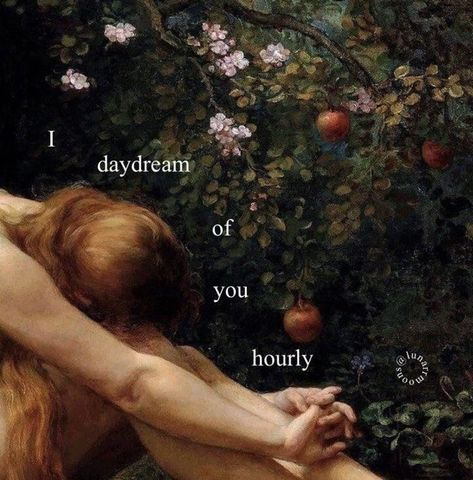

⋆˙⟡♡ || how i met ethan
when i was 16 years old, my parents decided to give me what i'd been asking for for years; a summer in france. on the third day of our stay, they'd sent me out of the hotel so they could "sleep", and i spent the morning walking through paris, nothing but adoration in my eyes. eventually, i grew hungry, and i found myself wandering into a little patisserie. I ordered far too much, my eyes much larger than my stomach. besides, i'd just bring some back for mama and papa. but as i'm walking out, carrying all these bags and boxes of pastries and breads and sweets, i bump into the prettiest boy i've ever seen in my life. i know the second my eyes meet his that i'll never move on. not only does he help me balance the bags and boxes, but when i offer him some of the food as thanks, he very promptly says, "fuck it," and leads me to a small park. we spend the entire day there, eating ourselves sick and laughing until long after the sun's set. he walks me back to my hotel, gives me his number, and we see each other every day for the rest of my trip. after i go back to school, we stay in touch, talking almost every day for years until i move to scotland.
⋆˙⟡♡ || how i met andy
i met andy after ethan did. them and ethan met over tiktok when they started stitching each other's videos (i, of course, watched this all occur from afar, giggling my ass off as i watched my best friend develop this absolutely debilitating crush), and when i went to visit ethan once, he introduced me to andy and the rest of his irl friends. andy and i instantly hit it off, and i (also) had a massive crush on this slovakian spitfire almost instantly. i spend a month in edinburgh, getting to know ethan's friends and spending a bit too much time with andy. by the time i go back to seoul, i'm vegan and head-over-heels in love with my two favorite people who are falling in love with each other.



⋆˙⟡♡ || the future~
the future? bright.

#star boi's drs ⋆。°✩#better c/r#reality shifting#shiftblr#shifting blog#shifting realities#shifters#desired reality#loablr#loa tumblr#shifter#shifting community
12 notes
·
View notes
Note
24?
24. Attempting to find out if they are single/available
Gregory sat alone at a bar, the name of which he had already forgotten, drinking cheap bourbon and feeling sorry for himself. Wallowing in self-pity was an unnecessary indulgence, of course. A complete waste of time. But, Gregory reflected, maybe he deserved a moment just to feel miserable.
He had uprooted his life for a new job position as the principal of an elementary school. He had bid farewell to his family and friends in Baltimore and moved into an apartment in the unfamiliar city of Philadelphia, fully prepared to start putting his degree to good use. And then, in the final moments, the rug was pulled out from under him.
We regret to inform you that we have chosen to move forward with another candidate...
The bourbon burned on the way down. Gregory welcomed the feeling. Something must have happened after he accepted the job offer. Maybe a higher-up had decided last-minute that Gregory didn't make enough eye contact during the interview, that his demeanor was too stoic and off-putting, that he wouldn't have been a good fit. Or, maybe, Gregory's job offer had been revoked in favor of a nepotism hire, or...
Gregory's train of thought was interrupted by a voice that seemingly materialized from somewhere near his left shoulder. "Hey! I saw you were sitting alone and I thought, whoa, what a coincidence, I'm also by myself."
Alarmed, Gregory turned to see a white guy wearing a blue plaid shirt in the seat next to his. Plaid Shirt held out his phone, grinning. On his phone screen was the webpage for The Washington Post's online Saturday crossword; in his other hand was a half-empty margarita. Gregory disliked him immediately in the same way he disliked car crashes and slightly asymmetrical flowerbeds — despite his best efforts, Gregory could not take his eyes off him.
"You seem like a big crosswords guy," said Plaid Shirt, completely ignoring the less-than-thrilled expression on Gregory's face. "I already did The New York Times crossword this morning, but we've still got The Washington Post."
Leave me alone, Gregory wanted to say — but Gregory did in fact enjoy a good crossword, and there was something about the well-meaning naivete written across the guy's face that made Gregory want to buy him a drink. "Okay," he said, instead. A thought occurred to him. "If you're hitting on me —"
"Oh, no, no!" Plaid Shirt said, his face pink. He set his phone on the table, angling it toward Gregory, and took a sip of his margarita. "I was actually on a date with someone earlier, but he left after we got into an argument about the electoral college. Pretty sure he's gonna ghost me later. Honestly, it just looked like you needed a friend. Unless..."
"Unless what?" Gregory prompted, although a part of him knew where this was heading. He glanced at Plaid Shirt's phone and tapped SIAM into 26-across ("India's neighbor on a Risk board").
"Well," Plaid Shirt said, hesitantly, "I did say that guy was gonna ghost me later. So, um, is there someone waiting for you at home, or..."
"No," Gregory said. "No, I just moved here."
"Oh." A small, hopeful smile. "I'm Jacob, by the way."
"Gregory," Gregory said. And then, because alcohol had made him bolder — or maybe because Jacob was weird in a way that put Gregory at ease somehow, like he didn't have to worry about eye contact with this guy who thought doing crosswords with strangers at bars was normal — Gregory added, "Can I get your number?"
#this is kind of an au that pretends zach doesn't exist#i'm sorry zach#hilleddie#abbott elementary#jacob hill#gregory eddie#my fanfiction
10 notes
·
View notes
Text

TruFynd redefines recruitment by delivering innovative and customized talent solutions that meet the unique demands of modern businesses. From sourcing niche professionals to streamlining hiring processes, we ensure your organization has the workforce it needs to succeed. Learn how TruFynd’s expertise can help build your dream team in this comprehensive blog.
#TruFynd tailored recruitment#customized hiring solutions#niche role recruitment#lateral hiring experts#leadership talent acquisition#efficient recruitment processes#talent sourcing specialists#TruFynd talent acquisition#innovative hiring strategies#recruitment agency India
0 notes
Note
wait they managed not to broadcast any force india cars for a weekend?? when and why did this happen??
Oh this is a severely fucked up occurrence that I will try to stay brief about but. Basically in 2012 formula one raced in Bahrain as a pretty much implicit sportswashing measure (I'm wary of throwing the term around but f1 had cancelled the race in 2011 due to 'political unrest' aka mass protests from a civilian population that were being violently put down, and in 2012 were explicitly asked to return in what was seen by most as the Bahrain government trying to show they had returned to normal and there were definitely no more human rights abuses happening.) This was widely condemned by both international charities and local activists but Bernie insisted it was all good and they would race no matter what. To put into perspective how fucked the situation was, a protester was killed the weekend of the race.
(side note if you look into this deeper and actually investigate the politics going on behind a Motorsport pov a lot of drivers showed their asses here in their response and it's interesting especially in the case of Sebastian and Lewis how they reacted here VS how they would probably have reacted today.)
So that's. The background. Now here's the insane part. Obviously there were local protests against this, a lot of them. But only one incident really seemed to rattle f1 and that was a hire car of Force India mechanics had a petrol bomb thrown at it. Nobody was hurt but subsequently Force India decided not to participate in the later practice session so the staff could all return to their hotels before it got dark outside.
F1 was. Pissed. How dare you ruin our messaging. There is nothing wrong here, we're all having a great time here, there is no unrest whatsoever the government and their money are doing a great job. Also, this was back when news breaking on twitter was a fairly new concept so the process of these rumours coming out via twitter were very very messy and drew more attention to the sport.
So in what was probably an effort to avoid this online speculation and people demanding answers, during the first practice session, f1 decided the world was populated entirely by toddlers with no object permanence, and if they just didn't SHOW force india, nobody would remember to ask them about the force india petrol bomb rumours. So you had one session where every single team was getting screen time EXCEPT force india - like, I remember it being commented on as odd at the time - and a weekend where the camera kept cutting away from force india cars jarringly as much as it could.
73 notes
·
View notes
Note
there’s a super rich indian couple that is going to get married or maybe they already did, cus it’s been 2 weeks ppl are talking about it 😭😭😭😭
i have no idea who they are but i don’t think they’re celebrities…they are heirs of something🫢
👀👀👀what does the indian media say about them?
it’s anant ambani and radhika merchant 👀👀👀👀
Mukesh Ambani is the richest person in Asia with a net worth of $113 billion 💀
Anant Ambani is his youngest child
Obviously the whole family is famous for being rich but in the last decade or so, they've attracted more attention in the media for their extravagant parties, weddings etc and their tendency to bring out celebrities from India and abroad for these things (Beyonce performed at his daughter's wedding, Rihanna at his son's pre wedding ceremony etc)
Nita Ambani, Mukesh Ambani's wife is thought to be the mastermind behind this (she's Swati Moon and def lovesssss to be immersed in the material world). She was an ordinary school teacher when she married Mukesh in the 80s. The Ambanis are kinda like the Rockefellers of India but they weren't as rich in the 80s as they are today, with major stakes in every industry (esp telecom). Nita was strictly middle class and unused to living a life of luxury. Mukesh's younger brother Anil Ambani, who at the time was more successful and married to a Bollywood actress, Tina Munim (now Tina Ambani) would throw these parties with Tina and invite all these celebrities since those were Tina's friends and colleagues and Nita (according to popular lore) would get very jealous because she wasn't as glamorous as Tina and being a school teacher, she felt out of place etc at these functions. Moreover being the elder daughter in law meant she had more responsibilities esp since her marriage was an arranged one and Tina & Anil had a love marriage.
Cut to a few decades later. Her father in law passed away. Anil Ambani went bankrupt and Mukesh got richer and richer 🤑🤑🤑and finally Nita could shine. There began all this tacky extravaganza. She's just making up in old age for all the partying and celebrity shoulder brushing that she didn't get to do when she was younger. She was once an out of place school teacher but now she's the wife of the richest man in Asia, so she can pull her weight differently.
All of these media shenanigans are said to be her idea as Mukesh is known for being a very simple guy (he's Ashwini Moon) who's obsessed with his wife and will do anything for her.
Since this is the last Ambani wedding of this generation, they're kinda going all out for it. For the last 6 months they've been hosting various "pre-wedding rituals" and now last week, they finally got married.
The name Ambani in India is synonymous with wealth, we just think they're crazy rich people with nothing better to do than hire celebs as their show monkeys lol
17 notes
·
View notes
Note
any cool desi books/media to recommend??
Okay to be fair I am not the biggest consumer of desi media HOWEVER. I have a few niche favourites (some of them come from my research for my Major Work in my final year in high school but here's a quick list):
The Namesake by Jhumpa Lahiri - god this entire book changed me fundamentally. It was like watching my own life play in fast-forward and getting hit in places I didn't want to be hit. if you are a first-generation desi in a western country, you will be on the ground sobbing
If You See Me, Don't Say Hi by Neel Patel - a collection of short stories that methodically break down some of the most subtle and pervasive stereotypes within desi cultures. I've only ever had time to read the first two stories but I'm hoping to get the full book someday
Unaccustomed Earth by Jhump Lahiri - an anthology I read for my senior year as well. Another one of this heart-wrenching pieces that just resonate with me like damn.
The Aru Shah series by Roshani Chokshi - it's Percy Jackson But Make It Desi and honestly such a fun read!! Reading about the Potatoes (this is what the reincarnated Pandavas call themselves not joking) is always bound to make my day
The Age of Kalki series by Vishwas Mudagal - I read this purely for inspiration on my own original novel, and it was fun to use for comparisons for research and my writing. Also, spy stuff and action and all that
The Spider-Man: India comics - hey, desi stuff is desi stuff, and I enjoy anything that has my boy Pavitr in it (I'll enjoy it even more when @/marvelentertainment hires me to write him a book)
The Ms. Marvel show and comics - in Iman Vellani we trust 🙏 also my girl has such a wonderful variety of comics like. she's so cool. i love her. hoping that Iman does a masterful job as she writes Kamala's newest comic
18 Days by Grant Morrison - listen. there is a 2015 graphic novel and there is a 2010 artbook for the 2015 book. They are both the same thing: a retelling of the Mahabharata but make it electronic/futuristic. Read the graphic novel for the story, but I HIGHLY HIGHLY recommend the 2010 artbook as well because my god the ART is just gorgeous. It obviously provides insight on the creation of Morrison's 2015 book but god it is just. so so sooooo good. Mukesh Singh is a beautiful artist I need to have his art tattooed on me
Any desi movies from the 90s-00s - my experience with tamil movies in that time period have always been good ones!! They're chill, they're funny, they're silly, they're romantic, they're thrilling. literally all of my favourite song come from this period (don't disregard movies from later periods either, I watched Brahmastra a few months back and it was lit as fuck).
English translations of popular desi stories - and these stories can be anything. from ye old prevailing Ramayana and Mahabharata to anything written by contemporary desi authors. They've got a lot to share
On a side note me complaining to my desi friends that I want good tamil representation in western media often led to me getting smacked in the face with Never Have I Ever (by my DESI friends! who say it is very good!!) and i just want to say no. don't watch that. as a tamil person living in a western country, i apologise for who Devi Vishwakumar is as a person. i will personally pay for your therapy (has only watched two episodes and was immediately turned off)
I'm giving y'all a whole day to ask me whatever
#agni of wisdom#me when. me when i don't engage with desi stuff outside of funny tamil musicals#you can very much tell that most of the stuff is india-centric. and like. yeah. i'm sorry. i haven't really delved into desi media-#-in other countries aside for some research. india is not the only south asian country and i absolutely recognise the fact that i should-#-probably widen my horizons#MARVEL HIRE ME PLS 🙏🙏🙏 I CAN MAKE PAVITR SOOOO POPULAR YOU HAVE NO IDEA 🤪⚡ (<- delusional)#desi media recs#desi#desi books#desi tumblr#me having no idea what desi tags to use lmfao
37 notes
·
View notes
Text

Meanwhile, in an upscale suburb of Seattle, Washington, the Sharma Sisters from Hyderabad are still running their successful line of clothing stores.
At first, a small affair known as The Sharma Sisters' Indian Apparel Boutique sold sarees, where they sold sarees, dhoti kurta, salwar suits, and other items of Indian apparel.
Not a business fated for grand success in your average upscale Seattle suburb.
Then, as fate or karma would have it, they came into possession of something they came to call The Threads of Karma Cloth.

This, though super-science they didn’t understand, caused those who wore it (picked from a selected few) to become physically and psychologically attuned to the land of India. This, in turn, led to a much larger clientele in search of other less “esoteric” Indian apparel.
That's why they renamed their shops, which now had four in Washington state, to “You Are What You Wear Fine Indian Apparel.”
Which at last led them to branch out again with the opening of a shop in Boise City, Idaho.

To run it, they hired experienced local sales manager Pamela Sheridan, whom they insisted she and everyone she employed in their name dress in East-Indian style while doing so.
Pamela played along, being a go-along-to-get-along sort of person; plus she really needed the job. However, she had to ask.
“I’m sorry, but isn’t this cultural appropriation?” “Not to worry,” said the Sharma sister, who had helped her get dressed in her first saree. Trust me, wear what I’ve given you, and things will work themselves out before you know it.”

A week later, Pamela Sheridan was surprised to find this to be more true than she could have imagined.

A month later, Pamvati Shiravadan was reassuring her four new Western women hired for the coming opening day that they, too, would soon be as comfortable in their new free sarees as she was.

The four young ladies just hired, Vivian, Chloe, Lydia, and Willow, did not greet this news with much excitement.

However, a year later, the four, now known as Veha, Kavuri, Lakshmi, and Wishi, were more than happy on winning the outstanding sales team with accompanying big bonuses.
12 notes
·
View notes
Text
Lost, but Not Forgotten: The Madness of Youth (1923)
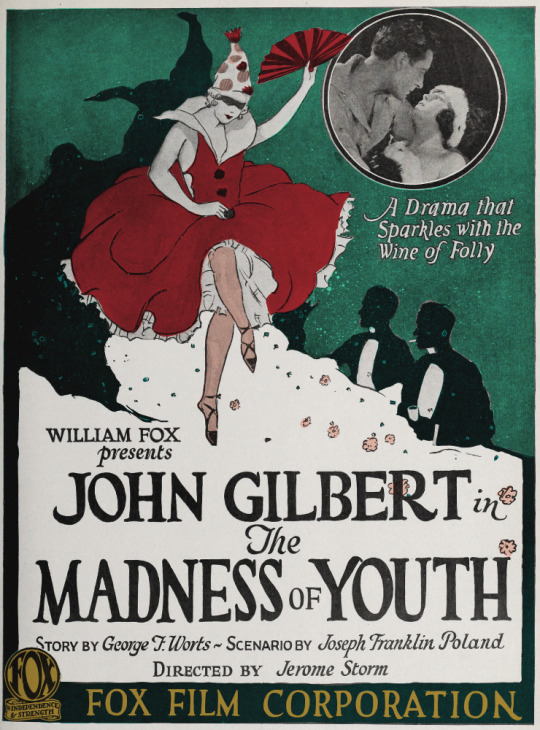
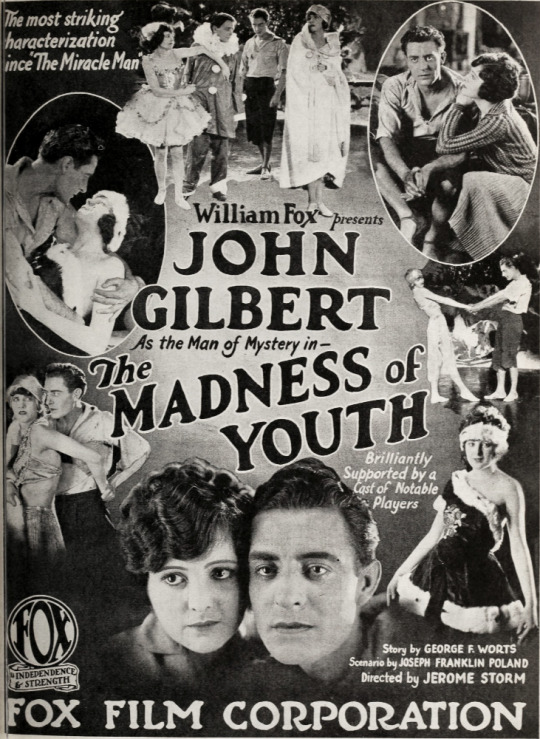
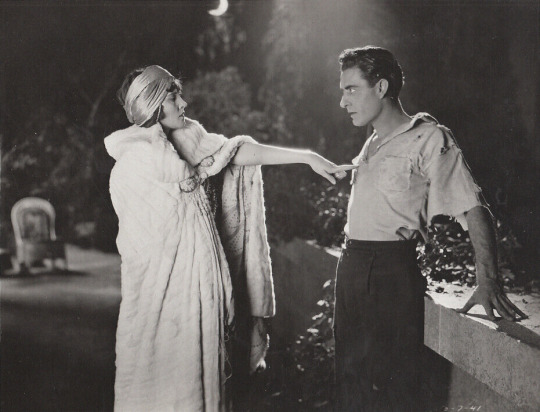
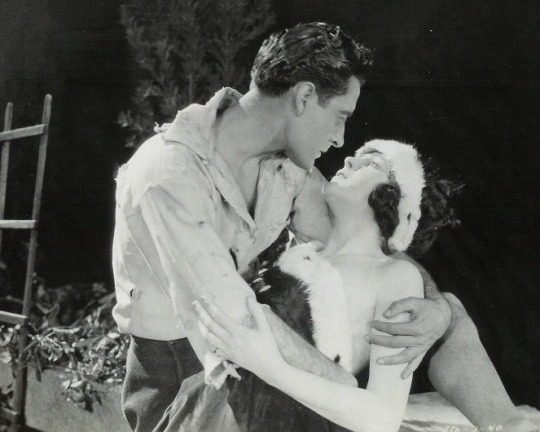
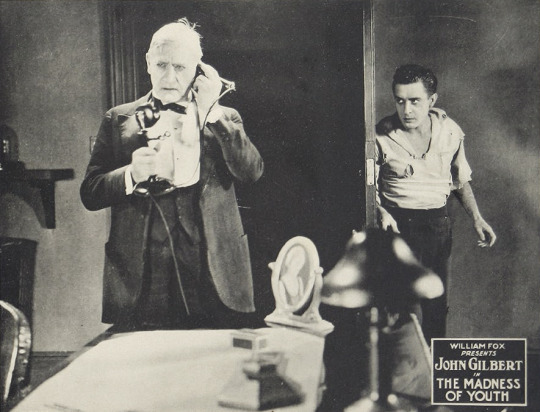

Direction: Jerome Storm
Scenario: Joseph Franklin Poland
Original Story: George F. Worts
Camera: Joseph August
Studio: First National Fox (production) & (distribution)
Performers: John Gilbert, Billie Dove, Wilton Taylor, George K. Arthur, Ruth Boyd, Julanne Johnston, Donald Hatswell, Luke Lucas, Dorothy Manners (potentially miscredited as Louise/The Dancer)
Premiere: 8 April 1923
Status: presumed entirely lost
Length: 4,719 feet, or roughly 51 minutes.
Synopsis (synthesized from magazine summaries of the plot)
A sophisticated, young gentleman, Jaca Javalie (Gilbert), is travelling on a cross-country train to California. As Javalie traverses the smoking car, it’s apparent he’s being tailed by a detective. However, somewhere between the smoker and the pullman, the detective loses the trail—as if Javalie had disappeared into thin air.
Later, out from the ditch beside the railroad, Javalie emerges—dressed now in tatters, a bindle stick slung over his shoulder. Javalie makes his way on foot to the California mansion of the Banning family.
Within the estate, the patriarch, Theodore P. Banning (Taylor), has built a private vault to secure his millions after being burned by bank failures in the past.
Banning’s children, Ted (Arthur) and Nanette, a.k.a. Nan (Dove), are now young adults and, though he loves them, he knows they’ve been spoiled rotten. Ted is selfish and unfeeling. He had brought home from France a wife, Jeanne (Boyd), but has since made her life miserable. Nan spends every night out gallivanting with the caddish mooch, Pete Reynolds (Hatswell), currently staying at the Banning’s as a guest.
Banning found comfort only in spiritualism—often communing from beyond the grave with his wife.
Javalie makes his entrance in the middle of another family quarrel. He presents himself to Banning, Sr. as a man with mystical powers, which he learned in India. He claims that has come to the Banning home after visions of their familial strife, sure that he can bring them peace. Banning agrees to let Javalie stay a while. Something about Javalie’s manner has a quick effect on the younger Bannings, who begin acting with a bit more reverence and grace. At dinner, Javalie lays his mysticism spiel on a receptive audience, save for the guest, Reynolds.

George K. Arthur, John Gilbert, Billie Dove, Ruth Boyd, and Wilton Taylor in The Madness of Youth from Motion Picture Classic, June 1923
Later, the Bannings throw a lavish masquerade ball with the theme “winter frolic.” At the ball, Nan gets Javalie alone and says she doubts his supernatural gifts. He assures her he isn’t trying to fool her, and she takes that as flirting. The gentleman thief Javalie is softening.
Next, Jeanne approaches Javalie and pleads with him to save her husband from the temptation of a dancer hired for the ball, who has a reputation as a vampire.
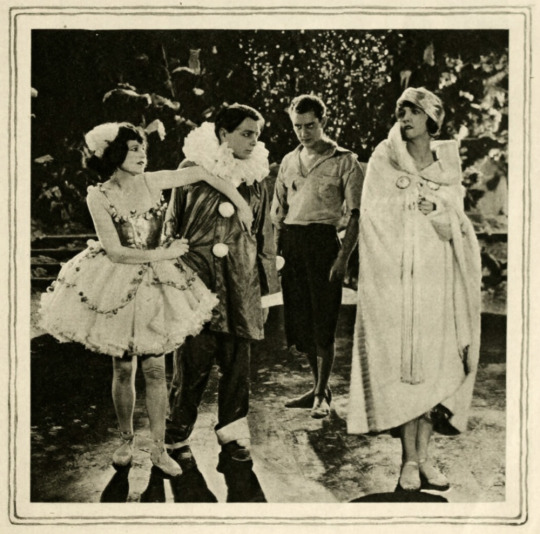
Ruth Boyd, George K. Arthur, John Gilbert, and Julanne Johnston in The Madness of Youth from Motion Picture Classic, June 1923
Javalie and Nan take a walk through the garden and she teasingly goads him into an embrace. Pleased with her machinations, Nan flutters away.
Now left alone in the garden, Javalie is greeted by the dancer. Under her mask is a familiar face, Louise (Johnston), Javalie’s ex-girlfriend. Louise threatens to expose him to the Bannings. Javalie reveals that he’s been planning to rob the Banning vault for three years. Louise agrees to publicly play-act that Javalie has saved her soul in exchange for a cut of the loot and Javalie’s hand in marriage. Javalie preaches to the crowd of attendees and, on cue, Louise repents. Jeanne and Ted reconcile.
After the party, Javalie finds Banning alone in his library. Javalie hypnotizes Banning and gets him to reveal the location of and combination for the vault. The two men were not alone however: Reynolds had been eavesdropping. Reynolds confronts Javalie and extorts him.

John Gilbert and Wilton Taylor in The Madness of Youth from Motion Picture Classic, June 1923
The next day, inspired by Javalie’s preaching, Ted and Jeanne decide to start again on their own. Banning happily offers to build them a home. Javalie is shaken by a note from Louise saying that his preaching worked better than expected and she did, in fact, feel reformed and was off to make amends with her family.
Disturbed by Louise’s actions, Javalie defiantly steels himself and heads to the vault, combination in hand. However, when Javalie reaches the vault door, he’s overwhelmed and faints. When he comes to, Javalie is surrounded by the Bannings. Ted plans to call the police. Nan holds Javalie close and begs for mercy through tears, claiming that Javalie must have had a change of heart just as they all had. Jeanne backs her up. Seeing Nan and Javalie together, Banning says he understands and the police are not called.
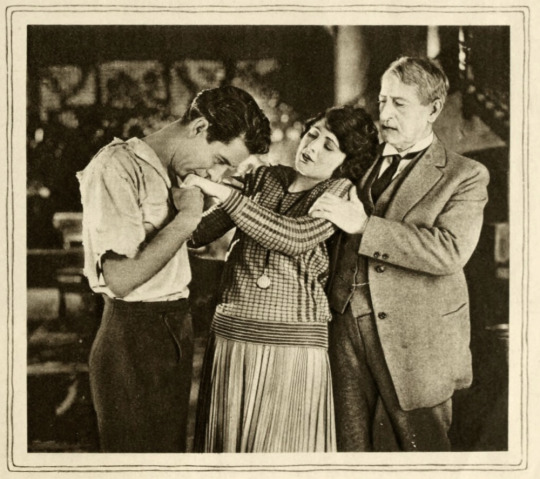
John Gilbert, Billie Dove, and Wilton Taylor in The Madness of Youth from Motion Picture Classic, June 1923
---
Points of Interest:
John Gilbert appeared in an astounding 90 silent films in his career from bit roles to starring roles and he even dabbled in writing and directing. While Gilbert had already worked on over 60 films by the time Madness of Youth came around, he was newly minted as a star just two years prior when he signed with Fox Film Corp. Gilbert would truly break out as a star when he signed with Metro-Goldwyn-Mayer in 1924. Of those 90 silent films, 58 are considered lost films, which means that only 35% of Gilbert’s film work is known to survive today.
Madness of Youth is one of many films believed to be lost after the 1937 Fox vault fire. In the summer of 1937 at the Fox vault in Little Ferry, NJ a fire broke out that destroyed a majority of films produced by Fox before 1932 as well as films from other studios, most notably Educational Pictures. The fire also killed a child in a neighboring building. All in one night, thousands of films were lost, leaving a gaping hole in our film heritage.
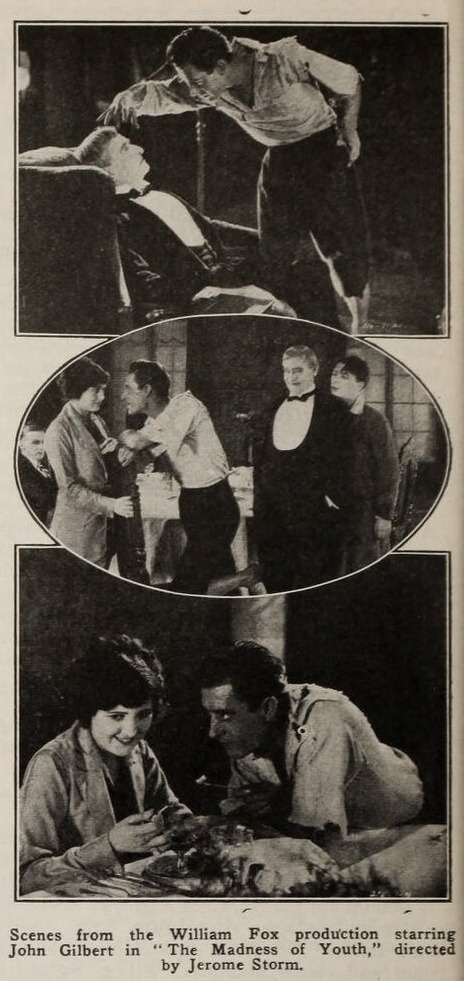
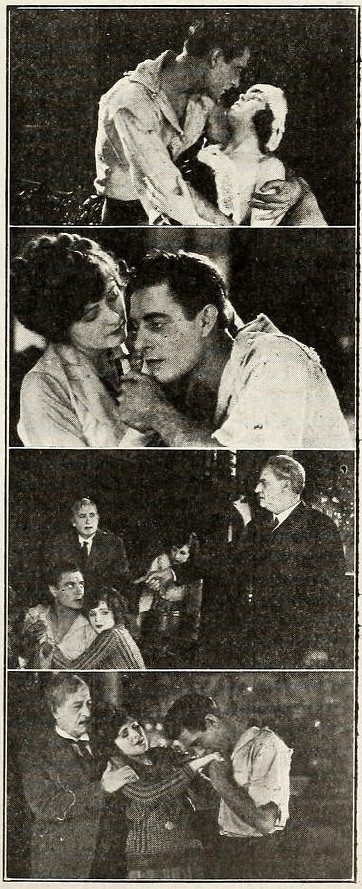
from Motion Picture News, 7 April 1923 and Exhibitors Trade Review, 28 April 1923
☕ Buy me a coffee! ☕
---
Transcribed Sources & Annotations over on the WMM Blog!
#lost but not forgotten#lost film#1920s#1923#John Gilbert#Billie Dove#silent era#silent movies#silent film#american film#fox film#classic hollywood#old hollywood#classic movies#classic film#film#movies
29 notes
·
View notes